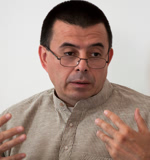| Töltsd le és telepítsd a nélkülözhetetlen betűtípusokat(s) Hogy megtekinthesd a Szanszkritot annak teljes fényében Olvass Transzliteráció (2) (magyar) hogy teljes mértékben átlásd a transzliterációs rendszert |
Jyotsnā (Jyotsna) (English)
Holdfény
-A nagy Brahmānanda kommentárja a Haṭhayogapradīpikā-hoz-
|
| Only active links appear in dark orange bold letters in the above index |
| 0 translated stanzas (with commentary) out of 388 |
Introduction
Hi, Gabriel Pradīpaka once again. Today is a great day as I start the translation of this monumental work. Jyotsnā is the authoritative superb Brahmānanda's commentary on Haṭhayogapradīpikā --wrongly-written Hatha Yoga Pradipika-- (one of the most important scriptures dealing with the Haṭhayoga science). There are four important scriptures on Haṭhayoga:
(1) Haṭhayogapradīpikā (by Svātmārāma); (2) Gheraṇḍasaṁhitā (by Gheraṇḍa); (3) Haṭharatnāvalī (by Śrīnivāsabhaṭṭa Mahāyogīndra) and (4) Gorakṣasaṁhitā (by Gorakṣa).
Why to translate Jyotsnā? This is a good question. The full story now:
When I started translating the third section of Haṭhayogapradīpikā, I became aware of the existence of Jyotsnā (lit. Moonlight). It is called "Moonlight" because just like it is traditionally said that the moon refreshes through its rays (while the sunrays heat), so this commentary refreshes one's own mind through its teachings. Therefore, I made the decision to make my translation of that third section fully concordant with the interpretation given in Jyotsnā by the great Brahmānanda. In fact, within my notes of the third section I began adding fragments or entire translations of his comments on the stanzas. His scholarship and vast Haṭhayoga knowledge elucidated for me many obscure passages indeed. At any rate, the first two sections were already translated without resorting to Jyotsnā, but only to my scarce knowledge and experience of Haṭhayoga. So, I decided to make them agree with the Jyotsnā's interpretation step by step.
But, something occurred suddenly. The inner Voice told me that I should translate the entire Jyotsnā and in the process also update my translation of the first two sections. I hesitated a little because I "only" had (and have) Jyotsnā in devanāgarī (in original Sanskrit signs). No, I did not need to have the transliteration in IAST because after so many years studying Sanskrit I think I master devanāgarī to a certain extent at least (ha!). Nonetheless, a translation by another author... or maybe some additional commentary on Jyotsnā would have come in handy really. When one translates Sanskrit texts, specially those dealing with a subject he does not master yet, there is much room for mistakes. Well, I had to accept my condition and go on with the certainty that the Power of the Lord will help me and fill the gap.
Who is the Lord? He is named in many ways: Śiva (Auspicious), Brahma (Absolute), Ātmā (Self), Mahāviṣṇu (Great Viṣṇu), etc. He remains in complete unity with His Power or Śakti. This Power is in turn named in multiple ways too: Bala (Force), Parāśakti (the highest Power), Spanda (Vibration), etc. Some people, specially the atheists, could think that I am following a religion or something since I am speaking about the Lord in the entire website practically. NO. I respect all religions and accept the role they play in this world, but I belong to none. So, when I say "the Lord" I am speaking about the Source of all that has been manifested as well as of all that still remains unmanifested. In fact, the Lord is everything and everyone. According to some philosophical systems, the Lord is not oneself really. According to other systems, He is oneself. And even according to other philosophies, He is equal to and at the same time different from oneself. Beyond all these divisions in the viewpoints of those systems, one fact remains: the Lord IS. This is the important thing to keep in mind.
Another important thing to keep in mind is that when I speak about the Lord I am not referring to someone who is like a mere human being but "bigger". For example: He gets angry and destroys civilizations, or He gets pleased and rewards people with impressive boons. No, I am not referring to that type of Lord. When I mention the Lord I am mentioning the cosmic Entity that manifests, maintains and dissolves the universe over and over again. He is also responsible for "concealing" and "revealing" one's essential nature. And He is beyond all those things as well, dwelling alone in His fullness. Words are never sufficient to describe His nature and activities indeed. Veda-s call Him simply "That". Even atheistic people, despite they can deny a "human-like" god to a certain extent, cannot deny the presence of "That" behind all this comedy known as the universe. For instance, one can follow the theory of Big Bang to its very grounds, but in the end, he will not able to describe That who existed before the Big Bang nor His reasons to start the Creation. Sooner or later, everyone and everything will return to That because everyone and everything arose from That.
This talk about the Lord has to do with something I want to announce now: The translation of this scripture is not only another translation on my list but "a synthesis of grammatical and philosophical knowledge". Why? Well, another long story I will simplify for you now:
Some years ago (maybe two or three, I do not remember the exact date), a visitor asked me for a more complete word for word translation. He wanted me to add a definition of the words apart from their mere meanings. For example: नमः शिवाय - Namaḥ śivāya - "Salutation (namas) to Śiva (śivāya)" [normal word for word translation] should be transformed into something like this » नमः शिवाय - Namaḥ śivāya - "Salutation (namas - nom. sing. of namas n.) to Śiva (śivāya - dat. sing. of śiva m.)" [extended word for word translation; I changed the colors for the sake of convenience]. That means "namas - nominative singular of namas, neuter gender" and "śivāya - dative singular of Śiva, masculine gender". The extended word for word translation would be meant for students of Sanskrit grammar desirous to know how a "real" text in the "real" world is to be translated. Of course, at that time I thought that the visitor was being a little "optimistic" about my own capacities in delivering detailed Sanskrit translations, as the task was (and "is") so time-consuming and hard that only an insane person could undertake it with a big smile on his face, hehe. I said "no" to him because the work was already crazy with normal "word for word" translations.
Well, I made the decision to implement his idea... and I am giving him credit now for that despite I cannot remember his name... but I will go even deeper: I will explain within reach of my own capacities how the grammar works in practice. Thus, there will be three divisions per document: "normal translation" (word for word), "a pure translation" (with Sanskrit at minimum) and "a grammatical study" (extended word for word translation plus further explanations about Sanskrit grammar). For example: the first document of Section 1 (consult the above index) includes the first stanza along with its respective commentary. Well, there will be three parallel documents then: (1) With the normal word for word translation of the first stanza plus the commentary (full of explanatory notes dealing with the topic of the stanza/commentary, of course) --this is intended for people wanting to read the text along with all Sanskrit words; additionally they can also verify that I am not cheating--, (2) Keeping the same structure but reducing Sanskrit content at minimum --this is intended for people wanting to read the text without getting tangled up with too many Sanskrit terms during the process--, and (3) With an extended word for word translation (full of explanatory notes dealing with Sanskrit grammar) --this is intended for students of Sanskrit grammar ... from rookies to scholars--. There will also be a document exclusively containing a list with all the abbreviations I will use in the grammatical studies. The list will be updated constantly as I advance in my task.
Therefore, through my work on Jyotsnā I am not only delivering a translation to the visitors but also forming/improving students of Sanskrit grammar, who will become translators later on. A better knowledge will bring about better translations in the future.
Back to the Lord now: If you are someone that desires to become a Sanskrit translator, you need to know the nature of the Lord and His Power or Force. He appears in the form of a Group or "Kula". This Kula has been explained in detail in Parāprāveśikā according to the teachings of the sages Abhinavagupta and Kṣemarāja. In any case, I will simplify that explanation now for the Sanskrit students to understand how to undertake the process of translating in a practical manner. There are three aspects: (1) knower/perceiver, (2) power of knowledge/perception, and (3) knowable/perceivable. The Lord, in His innermost nature, is the Knower in everyone. His power of knowledge is the means through which He manifests and perceives the knowables or manifested objects. The knowables are all those things than can be "known" or "perceived". All things from Māyā (ignorance - tattva or category 6) down to Pṛthivī (earth - tattva 36) are knowables or objects. Even the mind (tattva-s 14 through 16) is an object to the Lord. Have you understood this? If not so, read my pages dealing with Trika (overview) in the respective section.
OK, let us go on: When one translates a Sanskrit scripture, that abovementioned Kula is fully present. Of course, it is present at all times, whether or not one translates, but I want to use this knowledge about Kula in a situation related to the translation of a Sanskrit text for the students to learn something that is the key to success in their work. So, Kula is present in the form of the Lord (Knower) + His Power of knowledge + the knowables or objects. You might be wondering: "Where am I in Kula?". Well, if by "I" you refer to your ego (e.g. John, Jane, etc.), so your ego is the tattva or category 15 and therefore is a knowable. One's ego can be known by the Lord despite it is not so gross as a mere external object (e.g. a table). If by "I" you refer to your divine essence, then either you are the Lord (according to the nondualistic systems) or you dwell in the Lord eternally but you are not Him (according to the dualistic systems) or you remain in unity with the Lord but at the same time you are not Him completely --just like the light of a candle's flame is in unity with the flame but simultaneously it is not the flame as such-- (according to the nondualistic/dualistic systems). In any case, like a divine essence you stand in the "Knower" aspect of Kula (Group). Very well!
Now, you have to translate a Sanskrit scripture whose meanings are so unfathomable as the outer space. You think: "Oh my God, this is impossible!". NO, it is never impossible if you know the key to enter the "Knower" aspect of the Lord. Specially in the West, the power of intellect is extremely important. Apparently, the more powerful an intellect the more effective it will be to accomplish hard tasks like the present one of translating a complex Sanskrit text. This is "partially" true. Somehow, in the West some people insist on overlooking the Lord and His Power. Of course, this is also the play of the very Lord! Nonetheless, to be completely effective in all areas of life, one must know how to resort to the Lord always. Since He is the source giving rise to everything and everyone, it is not surprising that even if a weak person resorts to Him, he or she will become extremely powerful. This is described in detail in the third section of Spandakārikā-s.
Back to the process of translation, there are two phases: with intellect ON and OFF. Let me explain to you this: The Sanskrit text emerges from the depths of the Lord as everything else around (PC included in my case, hehe). That text appears before you as a knowable, in the form of Sanskrit characters, etc. His Power or Force extracted that text from Him, as it were. In this phase, the Kula or Group is fully functional, because you have the Knower, the Power of knowledge and the knowable, all of them totally operative. Your intellect (tattva 14), being a knowable is also ON at the moment. And, as your intellect is ON, your knowledge about Sanskrit grammar is fully manifest, i.e. you use the intellect to translate... you know, something like this, "This is a verb conjugated in Present Tense...", and so on. Your understanding of the text rests on the intellect and its inherent power of knowledge coming always from the Lord.
Nevertheless, however vast your knowledge about Sanskrit grammar may be, you will get sooner or later to a condition where you will NOT be able to understand what the author is talking about. In complex texts abounding in descriptions of divine mysteries, this situation is pretty common. The level of spiritual experience of the translator is almost never the same as the one of the sage who wrote the scripture. This will prove a real obstacle in your way, especially if you do not have any additional commentaries or translations of other authors. What to do then in order to overcome this obstacle? Some translators choose the process of a "running translation" (not a word for word one) because "it is easier" to bypass conflicting areas in complex texts. I dislike this practice, obviously, because it is a lack of respect toward both the scripture and the reader. It is just not fair to take advantage of the ignorance of most readers regarding Sanskrit grammar. Well, one may cheat all readers in the world perhaps, but he cannot ever cheat himself, let alone the Lord. This cheating will bring about karmic consequences too.
OK, let us push this fraudulent course of action aside and concentrate our minds on how to solve the problem in practice. Every time you face a conflicting area in a scripture and your knowledge about Sanskrit is not enough to go past it, you MUST resort to His Bala or Force (i.e. His Power). How? By turning off your own intellect directly or by a certain method. There are plenty of methods to stop the intellect (read the subsections "Meditation" and "The three means" within the section "Trika" to choose a method suitable to your own capacities). In the 9th stanza of the aforesaid third section of Spandakārikā-s, the method based on Unmeṣa is described. I prefer not to use any method and stop my intellect directly. As my breath going in and out is a kind of fuel to the mind, I simply stop breathing for, say, 30 seconds. While my breath is stopped, I arrest all mental activities by force. Then, I start breathing again, and after a while I repeat the process, and so forth. I practice this very often, even when I am not facing any challenge during the translations. I simply like to dwell with my intellect OFF. At any rate, if you cannot do this, try one of the innumerable methods to make your intellect silent. Therefore, the goal is to turn it off.
When you succeed in turning off your intellect, Bala, the Force of the Lord, swallows the Sanskrit text, viz. dissolves it in Herself. Why? Because in the absence of a mind being operative, the knowables just return to their subtle state, i.e. to the Force Herself (Śakti or Bala). The Force of the Lord and the Lord Himself cannot be separated. So, when the Sanskrit text returns to His Force, it also returns to the Lord. At this point, the scripture is not a knowable (an object of knowledge) anymore but the Knower. And when your intellect is activated again, the Force spits out the Sanskrit text into manifestation once more. But something starts to change as your intellect is turned off and on successively. At a certain moment, that conflicting portion of the text is not any longer an obstacle since its meaning is completely revealed. This is a mysterious process where the text appears first with its meanings hidden, and after turning off the intellect one or more times, the text appears with its meanings revealed. I cannot explain it in a better way.
Did I mean that divine inspiration can be practiced then? No, I just showed a way to enter a superior level of consciousness. As your essential nature is spiritual, you have the right to gain access to higher states where divine inspiration resides in its purest aspect. At the level of mere knowables (objects) your possibilities of getting divine inspiration are very limited. So, the process of stopping your intellect is a way to increase your odds. The rest is up to His Grace alone.
The states of "working" and "arrested" mind are also described in venerable Pātañjalayogasūtra-s. When your mind "works" (i.e. when it is on), that brings about saṁskāra-s or latencies in your causal body (like footprints on snow). These latencies will bring the never-ending good and bad fruits of your good and bad actions. In turn, when your mind is not working (i.e. when it is arrested), that also generates latencies but of a different kind. These latencies of arrested mind will not bear good or bad fruits at all. Well, a long subject really.
Finally, I want to dedicate this work to Parameśvara (the Supreme Lord) and His Bala (Force). By resorting to Him and His Power, a mere mortal like Gabriel Pradīpaka is able to accomplish the difficult task of not only translating word for word but also explaining in detail the way Jyotsnā has been written by venerable Brahmānanda. May, through the study of this work, His divine Grace touch you, visitor!
Well, let the holy Jyotsnā begin! ![]()
Further Information
Ezt a dokumentumot Gabriel Pradīpaka, a website egyik társalapítója készítette, aki spirituális guru és aki a Szanszkrit nyelv és a Trika filozófiai rendszerben jártas.
Szanszkrit, Yoga és indiai filozófiával kapcsolatosan, vagy ha csupán hozzászólni, kérdezni szeretnél, esetleg hibára felhívni a figyelmet, bátran lépj kapcsolatba velünk: Ez az e-mail címünk.





























